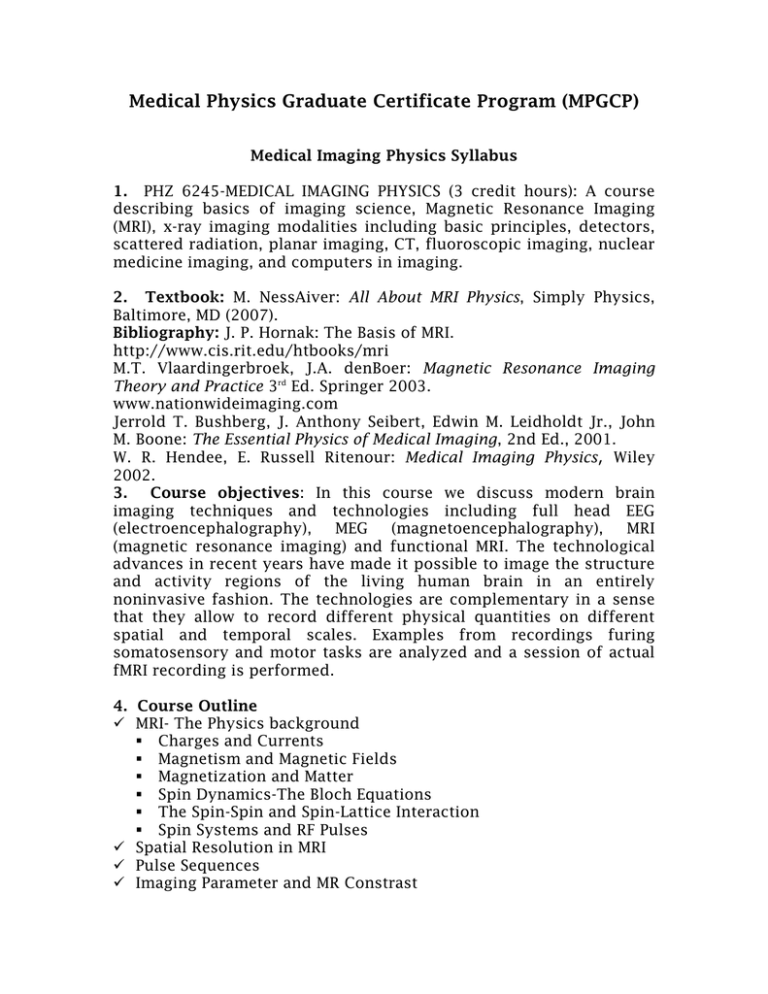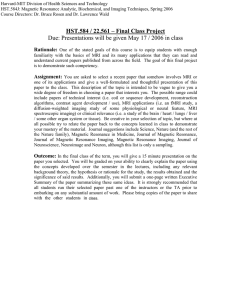Medical Physics Graduate Certificate Program (MPGCP)
advertisement

Medical Physics Graduate Certificate Program (MPGCP) Medical Imaging Physics Syllabus 1. PHZ 6245-MEDICAL IMAGING PHYSICS (3 credit hours): A course describing basics of imaging science, Magnetic Resonance Imaging (MRI), x-ray imaging modalities including basic principles, detectors, scattered radiation, planar imaging, CT, fluoroscopic imaging, nuclear medicine imaging, and computers in imaging. 2. Textbook: M. NessAiver: All About MRI Physics, Simply Physics, Baltimore, MD (2007). Bibliography: J. P. Hornak: The Basis of MRI. http://www.cis.rit.edu/htbooks/mri M.T. Vlaardingerbroek, J.A. denBoer: Magnetic Resonance Imaging Theory and Practice 3rd Ed. Springer 2003. www.nationwideimaging.com Jerrold T. Bushberg, J. Anthony Seibert, Edwin M. Leidholdt Jr., John M. Boone: The Essential Physics of Medical Imaging, 2nd Ed., 2001. W. R. Hendee, E. Russell Ritenour: Medical Imaging Physics, Wiley 2002. 3. Course objectives: In this course we discuss modern brain imaging techniques and technologies including full head EEG (electroencephalography), MEG (magnetoencephalography), MRI (magnetic resonance imaging) and functional MRI. The technological advances in recent years have made it possible to image the structure and activity regions of the living human brain in an entirely noninvasive fashion. The technologies are complementary in a sense that they allow to record different physical quantities on different spatial and temporal scales. Examples from recordings furing somatosensory and motor tasks are analyzed and a session of actual fMRI recording is performed. 4. Course Outline MRI- The Physics background Charges and Currents Magnetism and Magnetic Fields Magnetization and Matter Spin Dynamics-The Bloch Equations The Spin-Spin and Spin-Lattice Interaction Spin Systems and RF Pulses Spatial Resolution in MRI Pulse Sequences Imaging Parameter and MR Constrast Advanced Imaging Sequences MRI Hardware MEG-what is it? How to read MEG Data Decomposition and Spatiotemporal Analysis EEG-what is it? How to read EEG Data Techniques to improve the EEG Signal MEG vs. EEG Combining technologies 5. Methods of Instruction Class lectures and a session of actual fMRI recording. 6. Assessment procedures including tests, quizzes, and projects The letter grade is decided from quizzes (30% of the grade), three tests (70% of the grade) including the final exam; class participation and literature research are encouraged. 7. Grading scale A: 100-92 % A-: 91-86 % B-: 69-60% F: <60% B+: 85-80% B: 79-70%





